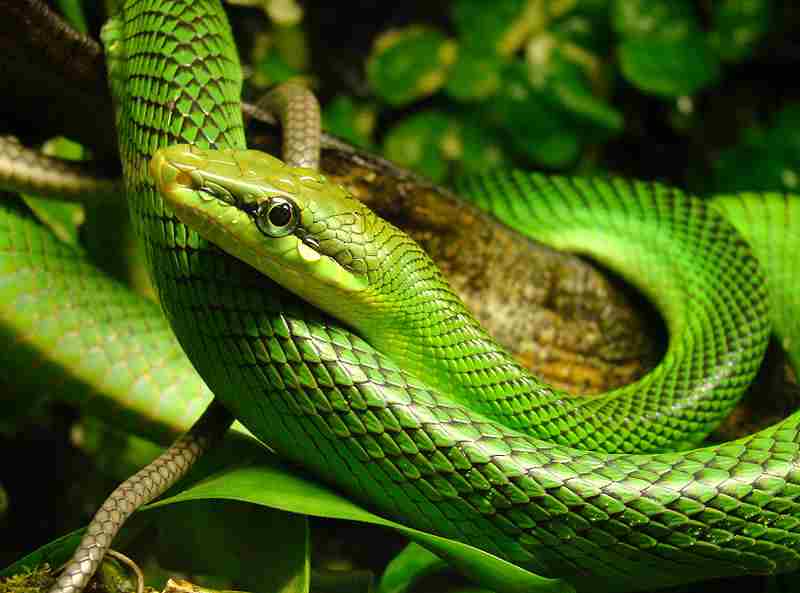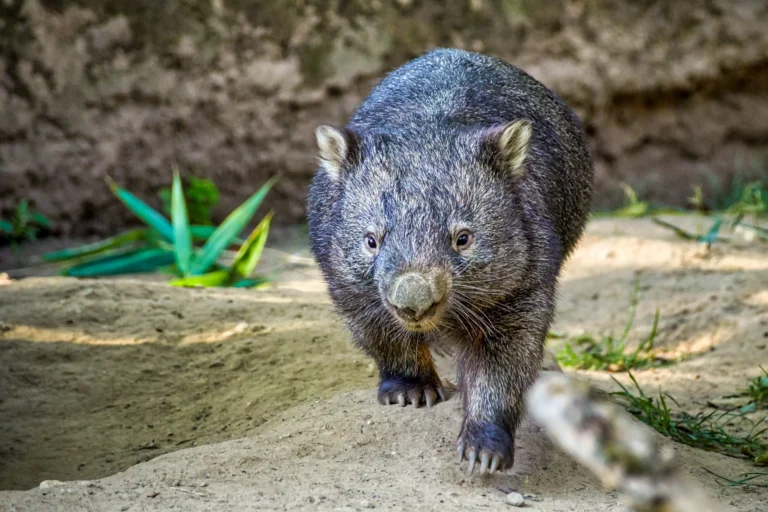Exploring Snakes in the Rainforest: Examples, Facts, Prey Organisms
Snakes in the rainforest include poisonous species like; eyelash viper, Amazon coral snake, South American rattlesnake, bushmaster, green mamba, gaboon viper, king cobra, and lancehead; as well as non-venomous snakes like the emerald tree boa, Brazilian rainbow boa, green anaconda, yellow anaconda, and reticulated python.
Facts about snakes in the rainforest are; presence of numerous arboreal species, prominence of color camouflage, possession of gliders by some species, high overall species count, broad prey size range, apex predatory role, size disparity, aquatic habitat preference for some species, microclimatic thermoregulation, high adaptivity, and predation by raptors.
What snakes in the rainforest eat includes; lizards, rodents, turtles, fish, crocodilians, deer, birds, frogs, eggs, and slugs.
Amazon snakes include; false water cobra, chicken snake, green vine snake, boa constrictor
Pythons in the rainforest include; Burmese python, green tree python, African rock python, blood python, and carpet python.
This article discusses snakes in the rainforest ecosystem in terms of their examples, facts and prey organisms, as outlined below;
Examples of Snakes in the Rainforest
Facts About Snakes in the Rainforest
What do Snakes in the Rainforest Eat?
-Examples of Snakes in the Rainforest
*Poisonous Snakes in the Rainforest
Poisonous snakes in the rainforest are; eyelash viper, Amazon coral snake, South American rattlesnake, bushmaster, green mamba, gaboon viper, king cobra, and lancehead.
1). Eyelash Viper
The Eyelash Viper (Bothriechis schlegelii), found in the rainforests of Central and South America, possesses distinctive characteristics, including its coloration, size, horned scales, venom, arboreal lifestyle, nocturnal behavior, ambush predation strategy, and cautious temperament.
Exhibiting a vibrant and variable color palette, these vipers can range from bright green to yellow, brown, or even pink. This camouflages them effectively among the dense foliage.
Generally compact, with an average length of 60 to 80 centimeters, though some individuals may grow larger. Their relatively small size allows them to navigate the intricate rainforest environment.
One of their most notable features is the pair of elongated scales above each eye, resembling eyelashes. These "horns" contribute to their common name and aid in breaking up their outline, enhancing their concealment.
Possessing potent hemotoxic venom, Eyelash Vipers are capable hunters. Their venom primarily targets blood cells, causing tissue damage and impacting their prey's circulatory system.
Highly arboreal, these vipers are skilled climbers, utilizing their prehensile tail to grasp branches. Their excellent adaptation to tree-dwelling allows them to ambush prey and avoid ground predators.
Primarily nocturnal, Eyelash Vipers are most active during the night, allowing them to capitalize on the cooler temperatures and stealthily hunt their prey.
Adopting an ambush strategy, they patiently wait for small mammals, birds, or amphibians to pass by before striking with precision.
While venomous, Eyelash Vipers are generally not aggressive unless provoked. They rely on their cryptic coloration and ambush tactics for defense and predation.
2). Amazon Coral Snake
The Amazon Coral Snake (Micrurus spixii), inhabiting the rainforests of South America, can be distinguished based on its color, size, venom, diurnal habits, burrowing tendencies.
Displaying distinctive rings of black, red, and yellow, the Amazon Coral Snake exhibits the classic warning coloration associated with venomous species.
Typically small and slender, with an average length ranging from 40 to 70 centimeters. Their sleek build allows for agile movement through the forest undergrowth.
Possessing potent neurotoxic venom, the Coral Snake's bite can affect the nervous system, leading to respiratory failure. Despite their venomous nature, they are reclusive and rarely pose a threat to humans unless handled.
Unlike some nocturnal snake species, the Amazon Coral Snake is primarily diurnal, being active during the day. This behavior aligns with their visual hunting strategy.
Coral Snakes often display burrowing behavior, seeking refuge in leaf litter or soil. This helps them conceal themselves and avoid potential threats.
Known for their elusive and secretive behavior, Amazon Coral Snakes are skilled at avoiding confrontation. They prefer to escape rather than confront potential threats.
Feeding on smaller snakes, lizards, and amphibians, Coral Snakes are adept predators. Their potent venom immobilizes prey efficiently.
Featuring a small, pointed head, Coral Snakes lack prominent heat-sensing pits found in some venomous snakes. Their head shape contrasts with that of vipers, aiding in identification.
3). South American Rattlesnake
The South American Rattlesnake (Crotalus durissus), a venomous pit viper inhabiting rainforests. This section discusses its appearance, morphological features, venomous secretions, and behaviors.
Typically featuring a cryptic color pattern that blends with the forest floor, ranging from browns and grays to greens. This aids in camouflaging amidst the lush vegetation.
Medium to large-sized, with an average length of 1 to 1.5 meters. Their robust build contributes to their role as apex predators in the rainforest ecosystem.
Possessing hemotoxic and proteolytic venom, the Rattlesnake's bite can cause tissue damage and blood clotting issues. The venom aids in subduing prey and serves as a defense mechanism.
Unique among snakes, they have a segmented rattle at the end of their tail. The rattle produces a distinctive sound when vibrated, serving as a warning to potential threats.
Equipped with heat-sensing pit organs located between their eyes and nostrils, allowing them to detect warm-blooded prey in their surroundings.
Primarily nocturnal, South American Rattlesnakes are more active during the night, utilizing their heat-sensing abilities to locate prey in low light conditions.
Employing an ambush strategy, they wait for prey to pass by before striking with precision. Their venom aids in quickly immobilizing and digesting the captured prey.
Generally solitary, these rattlesnakes are territorial and prefer to avoid confrontation. Encounters with humans are infrequent, as they tend to retreat when aware of approaching disturbances.
4). Bushmaster
The Bushmaster (Lachesis spp.) is a venomous pit viper found in the rainforests of Central and South America. It is characterized by its distinctive size, coloration, venom, pit organs, nocturnal habits, lethargic movement, solitary behavior, and long lifespan.
Among the largest venomous snakes, with some species reaching lengths exceeding 3 meters. Their substantial size contributes to their position as apex predators in the rainforest food chain.
Typically displays a brown or reddish-brown color, aiding in camouflage within the forest undergrowth. The patterned scales enhance their concealment.
Possessing potent hemotoxic and cytotoxic venom, the Bushmaster's bite can cause severe tissue damage and disrupt blood clotting. Though their venom is powerful, they are generally elusive and prefer to avoid confrontation.
Equipped with heat-sensing pit organs, located between their eyes and nostrils, enabling them to detect warm-blooded prey and navigate their surroundings effectively.
Primarily nocturnal, Bushmasters are more active during the night. Their behavior aligns with a sit-and-wait strategy, lying in ambush for prey to pass by.
Despite their large size, Bushmasters are capable of moving quietly and slowly, exhibiting a methodical and deliberate approach to hunting and navigating their environment.
Typically solitary in nature, they avoid confrontations and are not known for aggressiveness unless provoked. Encounters with humans are rare due to their reclusive habits.
Bushmasters have a relatively long lifespan, with some individuals living over 20 years in the wild. This longevity contributes to their ecological impact within their habitat.
5). Black Mamba
The Black Mamba (Dendroaspis polylepis), native to sub-Saharan Africa, is not typically found in rainforests but rather in savannas and rocky areas.
It may however traverse the rainforest on a migratory basis.
6). Green Mamba
The Green Mamba (Dendroaspis viridis), predominantly inhabiting the rainforests of West Africa, is characterized by its yellowish green color, slender build, and arboreal lifestyle, among other features discussed below;
Vibrant green scales, often with a yellowish or bluish tint, aiding in camouflage among the lush vegetation of rainforests.
Relatively slender and agile, with an average length of 1.5 to 2 meters. Their sleek build allows them to navigate the dense foliage with ease.
Possessing potent neurotoxic venom, the Green Mamba's bite can cause rapid paralysis and, if untreated, can be fatal. Despite their venomous nature, they are generally shy and prefer to avoid confrontation.
Highly arboreal, spending the majority of their time in trees. Their prehensile tail aids in climbing and maintaining balance on branches.
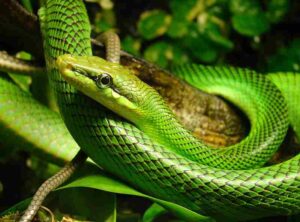
Unlike many venomous snakes, Green Mambas are primarily diurnal, being most active during daylight hours. This behavior aligns with their visual hunting strategy.
Known for their alertness and agility, Green Mambas are quick and adept at moving through the treetops. Their speed allows them to swiftly capture agile prey.
Typically solitary and territorial, Green Mambas are not known for aggressive behavior. Encounters with humans are infrequent due to their reclusive habits.
Featuring an elongated head and large eyes, the Green Mamba has sensory adaptations for hunting and navigating their arboreal environment.
7). Gaboon Viper
The Gaboon Viper (Bitis gabonica) is native to the rainforests and grassland ecosystems of sub-Saharan Africa.
Its morphological, aesthetic, and behavioral features are outlined below;
Among the heaviest and largest venomous snakes, with an average length of 1.2 to 1.8 meters. Their bulk and triangular head contribute to their distinctive appearance.
Featuring a complex pattern of geometric shapes and earthy colors, such as browns, blacks, and pale yellows. This intricate camouflage aids in their concealment among the leaf litter.
Possessing potent cytotoxic and hemotoxic venom, the Gaboon Viper delivers a formidable bite. While dangerous, they are usually docile and rely on their impressive camouflage for defense.
The Gaboon Viper's coloration, coupled with its ability to remain motionless for extended periods, enhances its camouflage. This allows it to ambush prey effectively.
Equipped with exceptionally long fangs, reaching up to 5 centimeters in length, which fold against the roof of the mouth when not in use. This adaptation aids in delivering deep bites.
Primarily nocturnal, the Gaboon Viper is more active during the night, relying on its keen sense of smell and heat-sensing pits to locate prey in low light conditions.
Despite their large size, Gaboon Vipers are slow-moving, relying on their ambush strategy rather than pursuit to capture prey.
Known for their generally placid temperament, Gaboon Vipers often rely on their impressive appearance and camouflage rather than aggression to deter potential threats.
8). King Cobra
The King Cobra (Ophiophagus hannah), found in rainforests and grasslands of Southeast Asia, is characterized by its significant length, olive coloration, diversified habitat and diurnal habits, among others.
Among the largest venomous snakes, with an average length of 3 to 4 meters, and capable of reaching over 5 meters. Their substantial size contributes to their apex predator status.
Olive to black in color, with pale yellow or cream-colored bands. The distinctive hood, when expanded, showcases a spectacle pattern, serving as a warning display.
Possessing potent neurotoxic venom, a King Cobra's bite can be fatal to humans. Despite this, they are generally shy and prefer to avoid confrontation, using their impressive size and hood as a deterrent.
Agile climbers and proficient on the ground, King Cobras navigate both the forest canopy and the forest floor with ease. They are known for their adaptability to various habitats.
Primarily diurnal, King Cobras are most active during daylight hours. This behavior aligns with their visual hunting strategy, as they feed on other snakes, including venomous ones.
Typically solitary and territorial, King Cobras are not known for aggressive behavior unless provoked. Encounters with humans are infrequent due to their reclusive habits.
Among the most intelligent of all snake species, King Cobras are capable problem-solvers and exhibit complex behaviors, adding to their remarkable adaptability.
The King Cobra's long, slender body and hood make it easily distinguishable. The hood, when raised, is an iconic defensive display used to deter potential threats.
9). Lancehead
Lancehead refers to a group of venomous pit vipers (Bothrops genus) found in various rainforest regions of Central and South America. Characteristics include; significant size variation, color camouflage, venom, heat-sensing capabilities, as well as arboreal, terrestrial, nocturnal and crepuscular lifestyles.
Varying in size, lanceheads can range from relatively small, around 50 cm, to larger individuals exceeding 2 meters. The specific species within the genus will determine the size.
Typically featuring earthy tones such as browns and greens, providing effective camouflage in the rainforest environment. Some species may have distinctive patterns on their scales.
Possessing hemotoxic venom, lanceheads are capable of delivering a potent bite that can cause tissue damage and interfere with blood clotting. Though venomous, they are often not aggressive unless provoked.
They are equipped with heat-sensing pits located between their eyes and nostrils, enabling them to detect warm-blooded prey and navigate their surroundings effectively.
Lanceheads are adaptable, displaying both arboreal and terrestrial behavior. They can be found in trees, on the ground, or near water sources.
Many lancehead species are primarily nocturnal or crepuscular, being more active during the night or twilight hours. This behavior aids in ambushing prey.
Featuring a triangular head and vertical pupils, lanceheads share common viperid characteristics. The shape aids in their ability to strike and inject venom efficiently.
Employing an ambush strategy, lanceheads patiently wait for prey to pass by before striking. Their cryptic coloration enhances their effectiveness as concealed predators.
*Non-Venomous Snakes in the Rainforest
Non-venomous snakes in the rainforest include; the emerald tree boa, Brazilian rainbow boa, green anaconda, yellow anaconda, and reticulated python.
10). Emerald Tree Boa
The Emerald Tree Boa (Corallus caninus), native to the rainforests of South America, is characterized by its striking coloration, medium size, arboreal lifestyle, non-venomous nature, and nocturnal habits, among others.
- Emerald tree boas are distinguished by their striking emerald-green coloration, though some individuals may display a blue hue. A pattern of white or yellow scales along their body adds to their visual allure.
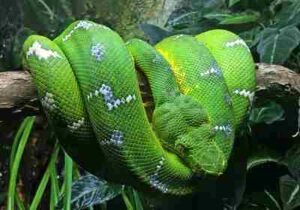
- Medium-sized arboreal snake, with an average length ranging from 1.5 to 2 meters. Its slender body and prehensile tail facilitate adept movement through tree branches.
- Highly adapted to life in the trees, the Emerald Tree Boa spends the majority of its time coiled on branches. Its prehensile tail aids in gripping and maneuvering in the canopy.
- Equipped with heat-sensing pits located along its upper lip, allowing it to detect temperature changes and locate warm-blooded prey in low-light conditions.
- Despite its intimidating appearance, the Emerald Tree Boa is non-venomous. It subdues prey by constricting, relying on its muscular body to overpower and consume small mammals and birds.
- Primarily nocturnal, the Emerald Tree Boa is more active during the night, utilizing its heat-sensing capabilities to locate prey in the darkness.
- Often adopts a distinctive resting position, coiled around tree branches with its head positioned in the center. This unique posture enhances its camouflage and serves as a strategic ambush point.
- Generally docile but may exhibit defensive behavior if threatened. The Emerald Tree Boa relies on its cryptic coloration and arboreal lifestyle to avoid confrontations.
11). Brazilian Rainbow Boa
The Brazilian Rainbow Boa (Epicrates cenchria) is native to South America, particularly the Amazon rainforest. This snake is characterized by is spectral coloration, medium size, arboreal and terrestrial behavior, as well as its docile temperament. These and more are discussed below;
- Distinctive iridescent sheen, displaying a spectrum of rainbow-like colors when exposed to light. The vivid hues contribute to its striking appearance.
- Medium-sized constrictor, with an average length of 1.5 to 2 meters. Its slender body and semi-prehensile tail enable adept movement through the rainforest vegetation.
- Adaptable to both arboreal and terrestrial environments, the Brazilian Rainbow Boa can be found on the ground and in trees. It utilizes branches for thermoregulation and hunting.
- Relies on environmental temperatures for thermoregulation. Basking on branches helps absorb heat, and the snake's iridescence may aid in camouflage and temperature regulation.
- Primarily nocturnal, the Brazilian Rainbow Boa is more active during the night, utilizing its excellent sense of smell to locate prey such as small mammals and birds.
- Non-venomous, the snake subdues prey by constriction. Its muscular body allows it to overpower and consume a variety of prey items.
- Marked by distinctive saddle-shaped patterns along its dorsal side. These patterns, along with the iridescence, contribute to its visual appeal.
- Generally docile in nature, Brazilian Rainbow Boas may exhibit defensive behavior if threatened. Proper handling and care are essential to ensure their well-being in captivity.
12). Green Anaconda
The Green Anaconda (Eunectes murinus) is native to the Amazon rainforest.
Some attributes of this snake discussed here include its size, coloration, aquatic lifestyle, constrictor behavior, nocturnal habits, thermoregulation, solitary nature, and cautious temperament.
- Among the largest and heaviest snakes, with some individuals exceeding 7 meters in length. Their robust build and aquatic adaptations contribute to their size.
- Olive to dark green, providing effective camouflage in the aquatic and vegetated environments of the rainforest. They may have blackish markings along their body.
- Highly adapted to aquatic habitats, Green Anacondas are proficient swimmers, utilizing rivers, streams, and swamps. They are known to ambush prey from the water.
- Non-venomous, Green Anacondas subdue prey by constriction. Their muscular bodies and ability to stretch their jaws wide allow them to consume large prey items, including aquatic mammals.
- Primarily nocturnal, Green Anacondas are more active during the night, relying on their keen sense of smell to locate prey, which includes capybaras, caimans, and other large animals.
- Despite their aquatic lifestyle, Green Anacondas occasionally bask in the sun to regulate body temperature. This behavior is often observed near water bodies.
- Typically solitary except during the breeding season. Mating rituals involve complex behaviors and can result in communal gatherings of multiple individuals.
- Generally docile, but can be defensive if threatened. Their large size and powerful constriction make them formidable predators, but they are not known for aggression toward humans unless provoked.
13). Yellow Anaconda
The Yellow Anaconda (Eunectes notaeus) is found in South America, particularly in wetland habitats and rainforests. It s characterized by its golden-brown coloration, aquatic lifestyle, constrictor behavior, nocturnal habits, and solitary nature, among other attributes.
- Considerably smaller than the Green Anaconda, with an average length of 2 to 3 meters. While substantial, it does not reach the extreme size of its larger relative.
- Typically yellow or golden-brown, with dark markings along its back. The coloration aids in camouflage within the swampy and vegetated environments it inhabits.
- Adapted to aquatic habitats, Yellow Anacondas are proficient swimmers, utilizing rivers, streams, and swamps. They often hunt in water and can remain submerged for extended periods.
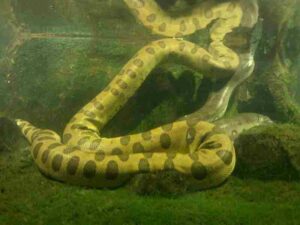
- Non-venomous, Yellow Anacondas rely on constriction to subdue prey. Their strong bodies and ability to stretch their jaws wide allow them to consume a variety of aquatic and terrestrial prey.
- Primarily nocturnal, Yellow Anacondas are more active during the night. They use their keen sense of smell to locate prey, including fish, amphibians, and small mammals.
- Like Green Anacondas, Yellow Anacondas may bask in the sun to regulate body temperature. This behavior is often observed near water bodies.
- Typically solitary, except during the breeding season when mating rituals involve complex behaviors. Communal gatherings are not as common as in the Green Anaconda.
- Generally docile, but may become defensive if threatened. While smaller than the Green Anaconda, the Yellow Anaconda exhibits similar behaviors, using its size and strength for predation and defense.
14). Reticulated Python
The Reticulated Python (Python reticulatus), native to Southeast Asia, including rainforests, is characterized by its large size, distinctive markings, climbing abilities, constrictor behavior, and opportunistic predation strategy. Below are details about this rainforest snake;
Among the world's longest snakes, with individuals capable of exceeding 6 meters in length. Their impressive size makes them apex predators in their habitat.
Marked by a distinctive pattern of intricate, net-like markings, giving rise to their name "reticulated." Colors range from yellow to brown, providing effective camouflage in their rainforest surroundings.
Agile climbers and proficient on the ground, Reticulated Pythons navigate both the forest canopy and the forest floor. They use their prehensile tails for climbing.
Non-venomous, Reticulated Pythons subdue prey by constriction. Their muscular bodies and sharp teeth aid in capturing and consuming a variety of mammals, birds, and reptiles.
Primarily nocturnal, Reticulated Pythons are more active during the night. They use their excellent sense of smell to locate prey in low-light conditions.
Typically solitary, except during the breeding season. Mating involves complex rituals, and females may lay large clutches of eggs, showcasing their reproductive strategies.
Known for their strength, Reticulated Pythons are powerful hunters capable of ambushing and overpowering prey, including large mammals, with their flexible bodies.
Generally shy and elusive, but may display defensive behavior if cornered or threatened. Encounters with humans are infrequent, but caution is advised due to their size and strength.
-Facts About Snakes in the Rainforest
1). Many Snakes in the Rainforest are Arboreal
Many snakes in the rainforest are arboreal, meaning they are adapted to living in trees. This characteristic allows them to navigate the dense vegetation, hunt for prey, and avoid ground-based predators.
Arboreal behavior is a common adaptation among rainforest snake species, showcasing their ability to thrive in the vertical landscape of the forest environment.
2). Color Camouflage is a Prominent Adaptation of Rainforest Snakes
Color camouflage is a prominent adaptation of rainforest snakes. Their diverse and cryptic coloration helps them blend seamlessly with the lush vegetation, providing effective concealment from both prey and potential predators in the dense and vibrant rainforest environment.
This adaptation enhances their ability to ambush prey and avoid detection in their natural habitat.
3). Some Rainforest Snakes (Chrysopelea) Possess Gliders as an Adaptive Feature for Locomotion
Some rainforest snakes, specifically those belonging to the Chrysopelea genus, possess gliders as an adaptive feature for locomotion.
These snakes are capable of gliding through the air by flattening their bodies and utilizing a unique lateral undulation, allowing them to cover significant distances between trees. This extraordinary adaptation enhances their ability to navigate the rainforest canopy and access different parts of their arboreal environment efficiently.
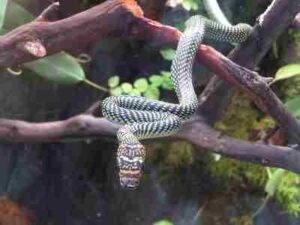
4). Hundreds of Snake Species can be Found in Rainforests
Hundreds of snake species can be found in rainforests, showcasing the incredible biodiversity of these ecosystems.
The diverse array of snake species play various ecological roles, contributing to the complex and interconnected food web of organic activity within the rainforest environment.
5). Prey for Rainforest Snakes Range Broadly in Size
Prey for rainforest snakes in the rainforest ranges broadly in size.
These snakes exhibit adaptability in hunting, capturing anything from small amphibians and birds to larger mammals, showcasing their diverse and flexible feeding strategies in the dynamic rainforest ecosystem.
6). Some Snakes in the Rainforest may Function as Apex Predators
Some snakes in the rainforest may function as apex predators, occupying the top of the food chain within their ecosystem.
These snakes play a crucial role in maintaining the ecological balance by regulating populations of various prey species and influencing the structure of the rainforest community.
7). Significant Size Disparity Exists Among Rainforest Snakes
Significant size disparity exists among rainforest snakes. The variety in snake sizes within the rainforest ecosystem ranges from small and slender species to some of the world's largest and most robust snakes, showcasing the diverse adaptations that enable them to thrive in this dynamic environment.
8). Many Large Snakes in the Rainforest Prefer Aquatic Habitats
As shown in earlier discussions within this article, many large snakes in the rainforest prefer aquatic habitats.
These snakes, often found near rivers, streams, and swamps, showcase an adaptation to an aquatic lifestyle. This preference aligns with their hunting strategies and underscores their ability to thrive in diverse environments within the rainforest.
9). Microclimates in the Rainforest Support Thermoregulation in Snakes
Microclimates in the rainforest support thermoregulation in snakes. The diverse thermal environments within the forest, including sunny patches, shaded areas, and water sources, allow snakes to regulate their body temperature effectively.
This adaptation helps optimize their physiological functions and behavioral activities in response to varying environmental conditions.
10). Snakes are Among the Most Adaptive Rainforest Animals
Snakes are among the most adaptive rainforest animals.
Their diverse behaviors, such as arboreal and terrestrial habits, coupled with various feeding strategies and camouflage, showcase their remarkable ability to thrive in the complex and ever-changing rainforest environment.
11). Rainforest Snakes are a Significant Component of Raptor Diet
Rainforest snakes are a significant component of raptor diet. These reptiles serve as a crucial prey item for various bird species, highlighting their ecological importance and role in the intricate food web of the rainforest ecosystem.
-What do Snakes in the Rainforest Eat?
1). Lizards
Lizards are a common and diverse prey for snakes in the rainforest.
Snakes play a key role in regulating lizard populations, contributing to the ecological balance of the rainforest by controlling the abundance of these reptiles in their habitat.
2). Rodents
Rodents are a significant part of the diet of snakes in the rainforest.
Snakes play a vital role in controlling rodent populations, acting as efficient predators that contribute to the ecological balance of the rainforest ecosystem by regulating the abundance of these small mammals.
3). Turtles
Turtles are occasionally part of the diet of snakes in the rainforest.
Some snake species, particularly those near water sources, may prey on turtles. This feeding behavior contributes to the complexity of the rainforest food web, showcasing the adaptability of snakes to various prey items within their habitat.
4). Fish
Fish are a notable part of the diet of snakes in the rainforest. Some aquatic or semi-aquatic snake species exhibit feeding behaviors that include hunting and consuming fish.
This adaptation allows these snakes to exploit diverse food sources and highlights their role in the ecological dynamics of rainforest ecosystems.
5). Crocodilians
Crocodilians are not typically part of the diet of snakes in the rainforest. While some large snakes may have the capability to prey on smaller crocodilians, such interactions are relatively rare.
Snakes in the rainforest more commonly feed on a variety of prey such as rodents, birds, lizards, and amphibians.
6). Deer
Deer are not a typical part of the diet of snakes in the rainforest.
Snakes in these environments generally prey on smaller animals such as rodents, birds, and amphibians.
The size and behavior of deer make them unlikely targets for rainforest snakes, which typically focus on more manageable prey within their ecosystems.
However, large constrictor snakes can occasionally prey on small members of the deer population, in the rainforest.
7). Birds
Birds are commonly part of the diet of snakes in the rainforest. Snakes, especially arboreal species, may feed on a variety of bird species.
This predation contributes to the ecological balance in the rainforest by regulating bird populations and showcasing the adaptability of snakes in utilizing diverse food sources within their habitat.
8). Frogs
Frogs are a common and important part of the diet of snakes in the rainforest. Snakes, both arboreal and terrestrial species, often prey on various frog species.
This feeding behavior plays a crucial role in regulating frog populations and highlights the intricate interactions within rainforest ecosystems.
9). Eggs
Eggs are a significant part of the diet of snakes in the rainforest. Snakes, particularly those that are ground-dwelling or arboreal, may feed on the eggs of birds, reptiles, and amphibians.
This feeding behavior contributes to the ecological dynamics of the rainforest, showcasing the adaptability of snakes to utilize diverse food sources within their habitat.
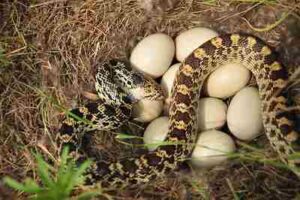
10). Slugs
While slugs are not commonly documented as a primary food source for rainforest snakes, some snake species, particularly those with a broader diet, may consume slugs opportunistically.
However, compared to more prevalent prey items like rodents, birds, and amphibians, slugs are not a major component of the typical snake diet in the rainforest.
11). Worms
Worms are not a typical part of the diet of snakes in the rainforest. Snakes in these environments generally feed on a variety of prey such as rodents, birds, amphibians, and reptiles.
Yet, in cases of extreme scarcity of preferred prey organisms, opportunistic snakes in the rainforest ecosystem may resort to worms and other invertebrates as a dietary supplement.
-Amazon Snakes
Snakes in the Amazon exhibit diverse characteristics and play crucial roles in the ecosystem.
Examples of Amazon snakes are; false water cobra, chicken snake, green vine snake, boa constrictor.
The False Water Cobra, known for its mimicry and rear-fanged venom, helps control rodent populations.
The Chicken Snake, a non-venomous constrictor, aids in regulating bird and small mammal populations.
The Green Vine Snake, arboreal and mildly venomous, contributes to insect and lizard control.
The Boa Constrictor, a large constrictor, plays a vital role in controlling mammalian prey, contributing to the overall ecological balance.
These snakes collectively influence prey dynamics and maintain biodiversity/species richness in the Amazon rainforest.
-Pythons in the Rainforest
1). Burmese Python
The Burmese Python (Python bivittatus), native to Southeast Asia, including rainforests, is characterized by its sheer size, distinctive coloration, diversified habitat preference, constrictor behavior, nocturnal habits, and ambush predation strategy.
Among the world's largest snakes, with individuals capable of exceeding 5 meters in length. Their substantial size contributes to their role as apex predators.
Typically features a distinctive pattern of dark blotches on a light background, providing effective camouflage in rainforest environments.
While capable of climbing trees, Burmese Pythons are often found on the ground. Their adaptability allows them to thrive in various habitats within the rainforest.
Non-venomous, these pythons rely on constriction to subdue prey. Their muscular bodies allow them to overpower and consume a wide range of mammals and birds.
Primarily nocturnal, Burmese Pythons are more active during the night, utilizing their excellent sense of smell and heat-sensing pits to locate prey.
Employing an ambush strategy, they patiently wait for prey to pass by before striking with precision. Their large size and powerful constriction make them formidable predators.
In some regions, Burmese Pythons have become invasive, causing ecological concerns due to their impact on local wildlife populations.
2). Green Tree Python
The Green Tree Python (Morelia viridis), native to New Guinea and northern Australia, and not the Amazon rainforest but a rainforest environment, is characterized by its emerald coloration, venom, heat sensitivity, constrictor behavior, and protective coiling, among others. Below are additional details;
Striking emerald green coloration, with some individuals exhibiting blue or yellow hues. This vibrant color helps them blend into the foliage of rainforest trees.
Highly adapted to life in trees, the Green Tree Python spends the majority of its time coiled around branches. Its prehensile tail aids in gripping and maneuvering in the canopy.
Mildly venomous, Green Tree Pythons use their venom to subdue prey. While not harmful to humans, their venom aids in digesting and immobilizing small mammals and birds.
Equipped with heat-sensing pits along their upper lip, allowing them to detect warm-blooded prey in low-light conditions.
Like other pythons, they are non-venomous constrictors, using their muscular bodies to subdue and consume prey, primarily small mammals and birds.
Primarily nocturnal, the Green Tree Python is more active during the night, utilizing its keen sense of smell and excellent camouflage for hunting.
Exhibits a unique resting behavior by forming a distinctive coil around branches during the day, providing both camouflage and protection.
3). African Rock Python
The African Rock Python (Python sebae), found in various habitats including rainforests, is characterized by its large size, distinctive patterns, habitat adaptability, constrictor behavior, nocturnal habits, ambush predation strategy, and caution with humans.
One of the largest snake species globally, with individuals capable of reaching lengths exceeding 6 meters. Their robust build contributes to their role as apex predators.
Typically features a distinctive pattern of dark blotches on a lighter background, providing effective camouflage in diverse environments, including rainforests.
While often associated with savannas, African Rock Pythons can also inhabit rainforests, showcasing their adaptability to different ecosystems.
Non-venomous, these pythons rely on constriction to subdue prey. They have a broad diet, consuming a variety of mammals, birds, and occasionally larger prey.
Primarily nocturnal, African Rock Pythons are more active during the night, using their keen sense of smell and heat-sensing pits to locate prey.
Employ an ambush strategy, lying in wait for prey to approach before striking with precision. Their large size and powerful constriction make them formidable predators.
While generally shy, encounters with humans can lead to defensive behavior. Due to their size and strength, caution is advised when navigating areas where African Rock Pythons are present.
4). Blood Python
The Blood Python (Python curtus), native to Southeast Asia, including rainforest habitats, is characterized by its distinctive reddish coloration, robust build, terrestrial lifestyle, nocturnal habits, constrictor behavior, defensive posture, and captivity popularity.
Distinctive red or reddish-brown coloration, providing effective camouflage in the dense vegetation of rainforests. Some individuals may exhibit darker patterns.
Medium-sized python with a robust build, reaching lengths of up to 1.8 meters. Their relatively compact size distinguishes them from larger python species.
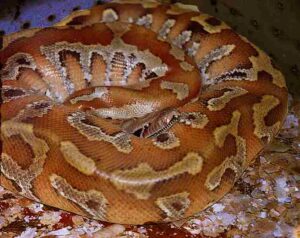
Primarily ground-dwelling, Blood Pythons are adapted to life on the forest floor, utilizing leaf litter and undergrowth for concealment.
Primarily nocturnal, these pythons are more active during the night, utilizing their excellent heat-sensing abilities to locate prey in low-light conditions.
Non-venomous, Blood Pythons rely on constriction to subdue prey. Their diet includes small mammals, birds, and occasionally other reptiles.
When threatened, Blood Pythons may adopt a defensive posture, coiling into a ball with their head hidden, showcasing their reclusive nature.
Blood Pythons are popular in the exotic pet trade, appreciated for their unique coloration. Proper care and understanding of their specific needs are crucial for their well-being in captivity.
5). Carpet Python
Carpet Pythons (Morelia spilota), which are found in various habitats, including rainforests, are characterized by their color variability, moderate to large size, arboreal and terrestrial characteristics, constrictor behavior, nocturnal habits, camouflage adaptation, and defensive nature.
Variable color patterns, adapting to different environments. In rainforests, they may display intricate markings that aid in camouflage among the foliage.
Moderate to large-sized pythons, with lengths ranging from 1.5 to 4 meters. Their slender build and agility contribute to their arboreal and terrestrial lifestyle.
Highly adaptable to different habitats, Carpet Pythons are proficient climbers, utilizing trees for hunting and basking, while also navigating the forest floor.
Non-venomous, these pythons use constriction to subdue prey. Their diet includes a variety of mammals, birds, and sometimes reptiles.
Primarily nocturnal, Carpet Pythons are more active during the night, utilizing their excellent sense of smell and heat-sensing pits to locate prey.
Their coloration, combined with a pattern that resembles dappled sunlight filtering through the forest canopy, enhances their camouflage and ambush strategies.
While generally docile, Carpet Pythons can exhibit defensive behavior when threatened, using their body to create an S-shape as a warning posture.
How Pythons Hide in the Rainforest
Pythons hide in the rainforest by utilizing their exceptional camouflage. Their coloration and patterns mimic the surrounding foliage, making them blend seamlessly into the dense vegetation.
This adaptation allows them to ambush prey effectively and avoid detection by predators or potential threats.
What Pythons Eat in the Forest
Pythons in the forest have a diverse diet that mainly comprises of small to medium-sized mammals, birds, amphibians, and reptiles (including other snakes)
The specific prey depends on the python's size, habitat, and local availability of food sources.
Predators of Pythons
While pythons are formidable predators, they do face threats from other animals in their ecosystems. Some predators of pythons are; black bears, alligators, Florida panthers, ans bobcats. Below is a brief discussion of each of these animals;
In their native habitats, black bears are not typical predators of pythons. However, in regions where invasive snake species, such as the Burmese Python, have become a concern, interactions with local wildlife, including black bears, can occur.
Alligators are potential predators of pythons. In areas where both species coexist, there have been documented cases of alligators preying on pythons and vice versa.
Florida panthers are unlikely to prey on adult pythons due to the significant size difference. However, they are opportunistic and might consume smaller members of the python population, as well as other snakes.
Bobcats may pose a threat to young or smaller pythons, as they are opportunistic predators capable of hunting a variety of prey in their habitat.
Conclusion
Examples of snakes in the rainforest include;
1. Eyelash Viper
2. Amazon Coral Snake
3. South American Rattlesnake
4. Bushmaster
5. Black Mamba
6. Green Mamba
7. Gaboon Viper
8. King Cobra
9. Lancehead
10. Emerald Tree Boa
11. Brazilian Rainbow Boa
12. Green Anaconda
13. Yellow Anaconda
14. Reticulated Python
Facts about snakes in the rainforest are;
1. Many Snakes in the Rainforest are Arboreal
2. Color Camouflage is a Prominent Adaptation of Rainforest Snakes
3. Some Rainforest Snakes (Chrysopelea) Possess Gliders as an Adaptive Feature for Locomotion
4. Hundreds of Snake Species can be Found in Rainforests
5. Prey for Rainforest Snakes Range Broadly in Size
6. Some Snakes in the Rainforest may Function as Apex Predators
7. Significant Size Disparity Exists Among Rainforest Snakes
8. Many Large Snakes in the Rainforest Prefer Aquatic Habitats
9. Microclimates in the Rainforest Support Thermoregulation in Snakes
10. Snakes are Among the Most Adaptive Rainforest Animals
11. Rainforest Snakes are a Significant Component of Raptor Diet
What snakes in the rainforest eat includes;
1. Lizards
2. Rodents
3. Turtles
4. Fish
5. Crocodilians
6. Deer
7. Birds
8. Frogs
9. Eggs
10. Slugs
11. Worms
Amazon snakes include;
1. False water cobra
2. Chicken snake
3. Green vine snake
4. Boa constrictor
Pythons in the rainforest include;
1. Burmese Python
2. Green Tree Python
3. African Rock Python
4. Blood Python
5. Carpet Python
